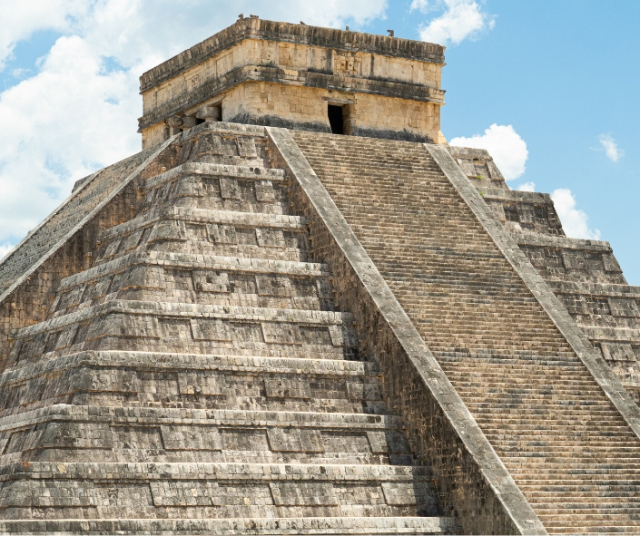Chichén Itzá , one of the most impressive archaeological treasures in Mexico and the world, stands majestically on the Yucatán Peninsula. This ancient Mayan archaeological site is a living testament to an advanced civilization that flourished in the region for centuries.
History of Chichen Itza
The Mayan Origin
The story of Chichén Itzá is a fascinating account of the evolution of a Mayan civilization that left a lasting mark on the Yucatán Peninsula, Mexico. This ancient archaeological site, dating back to the Preclassic period (circa 2000 BC – 250 AD), represents the cultural and architectural flourishing of the Mayans in the region.
During the Classic period (250-900 AD), Chichén Itzá began to consolidate itself as an important political and religious center. It is believed that its name, which means "Mouth of the Well of the Itzaes," refers to the presence of sacred wells used to supply water to the population.
One of the most notable aspects of the history of Chichén Itzá is its Toltec influence. It is believed that the Toltecs, from central Mexico, arrived in the region and left a deep mark on the architecture and religious practices of Chichén Itzá. This period of Toltec influence is associated with the construction of many of the site's most iconic structures, such as the Kukulcán Pyramid. However, over time, Chichén Itzá experienced a gradual decline, and the city was abandoned sometime during the 14th century. The exact reasons for its abandonment remain a matter of debate, but it is thought that drought, war and population pressure may have contributed to its decline. Despite its abandonment, Chichén Itzá was never completely forgotten. In the 19th century, explorers and archaeologists rediscovered the site, and throughout the 20th century, significant conservation and restoration efforts were undertaken.
The Toltec Influence
The Toltec influence at Chichén Itzá is an intriguing chapter in the history of this archaeological site. The Toltecs, originally from central Mexico, are believed to have migrated to the Yucatan Peninsula and exerted a significant influence on the culture and architecture of Chichén Itzá during a specific period.
This influence is manifested in various structures and architectural elements of Chichén Itzá. One of the most notable examples is the Kukulcán Pyramid, also known as El Castillo. This imposing step pyramid shows similarities to the pyramid of Quetzalcoatl in Tula, Mexico, a Toltec historical site. The arrangement of the stairs and the precise astronomical alignments in the Kukulcán Pyramid suggest a direct influence of the Toltecs on its design. Another example is found in the architecture of the Great North Platform. This structure presents columns and reliefs that are reminiscent of Toltec representations of warriors and important figures. These architectural elements show an evident mix of styles and beliefs between the Mayans and the Toltecs in Chichén Itzá.
Toltec influence also extends to the religious practices and beliefs of Chichén Itzá. The feathered serpent, known as Kukulcán in Mayan tradition and Quetzalcoatl in Toltec tradition, is believed to have played an important role in the site's religion. The feathered serpent is a recurring symbol in the structures and sculptures of Chichén Itzá, indicating an integration of Toltec beliefs into the city's religious life.
Decline and Abandonment
As the Postclassic period (900-1500 AD) progressed, Chichén Itzá experienced gradual decline, and the city was abandoned sometime in the 14th century. Although the precise reasons for its abandonment are debated, it is believed that factors such as drought, war and population pressure could have contributed to its downfall.
Stunning Architecture
The Castle (Pyramid of Kukulcán)
The Kukulcán Pyramid is the most iconic structure in Chichén Itzá and one of the most recognizable architectural landmarks in Mexico. This step pyramid stands approximately 30 meters high and is famous for its precise astronomical alignments. During the spring and autumn equinoxes, sunlight creates the illusion of a snake descending the main staircase, a tribute to the feathered serpent god Kukulcán.
The Temple of the Warriors
This architectural complex has impressive columns and sculptures representing Mayan warriors. A series of stairs lead to an upper platform, where a temple with intricate reliefs is located.
The Sacred Cenote
The Sacred Cenote is a natural well that played a significant role in Mayan religious practices. It is believed that the Mayans threw offerings, including gold and jade objects, into the cenote as a tribute to the water gods.
The ball game
Chichén Itzá is home to one of the largest ball fields in Mesoamerica. This space is witness to a ceremonial game in which players tried to score a ball in a hoop using only their hips. The game had religious and political connotations.
The Mysteries of Chichen Itza
The "Feathered Serpent" and the Stairway to Heaven
The structure known as the Venus Platform houses a sculpture of the " Feathered Serpent, " which some believe represents Kukulcán or Quetzalcoatl. Another mystery surrounds an internal staircase believed to lead to the underworld or the Mayan " Xibalbá ".
When you clap your hands at the base of the Kukulcán Pyramid, an echo is produced that imitates the song of a quetzal, a bird sacred to the Mayans. This acoustic phenomenon is amazing and has baffled scientists for years.
In 1988, Chichén Itzá was declared a UNESCO World Heritage Site and has been the subject of conservation efforts ever since. Today, it is one of the most popular tourist destinations in Mexico and the world, attracting millions of visitors each year who come to marvel at its history and architectural splendor.
